 Optical fibres are fibres of glass, about a few tenths of a millimetre in diameter, which are used to carry signals in the form of pulses of light. They are useful when lots of information has to be carried over long distances, without having to worry about electromagnetic interference. This type of communication can transmit voice, video, and computer data. 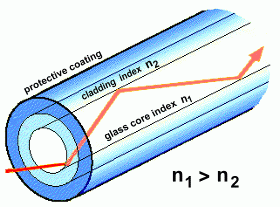
The glass fibre is surrounded by plastic cladding, which has a lower index of refraction than the glass. Any light rays sent down the inner glass fibre will either reflect off the outer surface of the glass, or refract back into the glass when they try to escape into the cladding (since ncladding < nglass). This total internal reflection keeps almost all the light inside the glass fibre. The glass 'pipe' can be bent, twisted around corners, and buried in cables, and any light signal sent in one end will emerge out the other ... at the speed of light in glass! 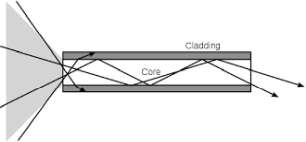 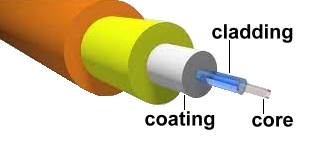 When light travelling in a transparent material meets the surface of another transparent material, two things happen; some of the light is reflected and some of the light is transmitted into the second transparent material at an angle that's changed because of refraction. If the light meets the surface of the first material at a large enough angle, (called the critical angle), almost all of it will be reflected. That's why when you look down onto the surface of water, sometimes you can't see the fish below. The light rays from the fish hit the surface at such a big angle that they are all reflected back into the water, and no light from the fish reaches your eyes. This is called total internal reflection. 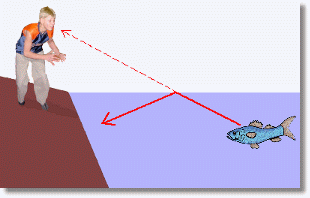 You may have experienced something similar from the fish's point of view, if you've ever opened your eyes underwater and looked at an angle towards the surface. Light from above the surface can't get through ... you can't see out. What you see instead is a mirror-like surface that represents the light from below reflecting back down into the water. Of course, the surface of water is rarely flat. Waves and ripples, as well as temperature differences, will make the critical angle for total internal reflection change from place to place, and from second to second. When you're searching for a glimpse of the fish below, some of the light from the fish may indeed get transmitted towards your eye as it hits the water at an angle less than the critical angle. But what usually happens is that this faint glimpse of the fish gets overwhelmed by the glare off the water, which is much brighter. Polarized sunglasses will filter out this glare and allow you to see whatever light from the fish manages to make it through the water's surface. However, if the fish is at an angle greater than the critical angle, you won't see any light from it at all. [Total internal reflection is really just refraction. Physics 20 students can find out more here.] 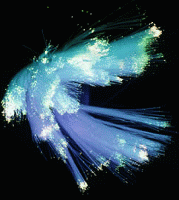 Sending light signals this way has many uses. Wherever electrical signals are used in copper wire, fibre optics can be used instead. Many more signals can be sent at the same time this way, and there is less loss of energy. Light moving through glass fibres is also less subject to distortion from outside electromagnetic sources like vehicle ignitions than electrons moving through copper wire. Sending light signals this way has many uses. Wherever electrical signals are used in copper wire, fibre optics can be used instead. Many more signals can be sent at the same time this way, and there is less loss of energy. Light moving through glass fibres is also less subject to distortion from outside electromagnetic sources like vehicle ignitions than electrons moving through copper wire. Optical fibre cables are much lighter and thinner than copper cables. This means that much less space is required in underground cabling ducts. They are also easier to handle. Optical fibres are much more difficult to steal information from, undetected, which is a great advantage for banks and security installations. They can also be used safely in explosive or flammable atmospheres. 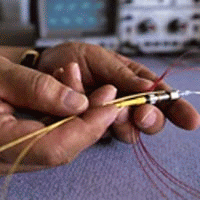 Optical fibres are more expensive per metre than copper wire. However, one fibre can carry many more signals than a single copper cable, and the large transmission distances mean that fewer expensive power boosters are required. Optical fibres cannot be joined (spliced) together as a easily as copper cable, so people who work with them require special training and expensive precision splicing equipment. Optical fibres are more expensive per metre than copper wire. However, one fibre can carry many more signals than a single copper cable, and the large transmission distances mean that fewer expensive power boosters are required. Optical fibres cannot be joined (spliced) together as a easily as copper cable, so people who work with them require special training and expensive precision splicing equipment.
Optical fibres are commonly used in surgery to relay images from tiny cameras inserted in patients' bodies. They are used in communication cables for telephone and high-speed Internet connections, and for cable TV. |